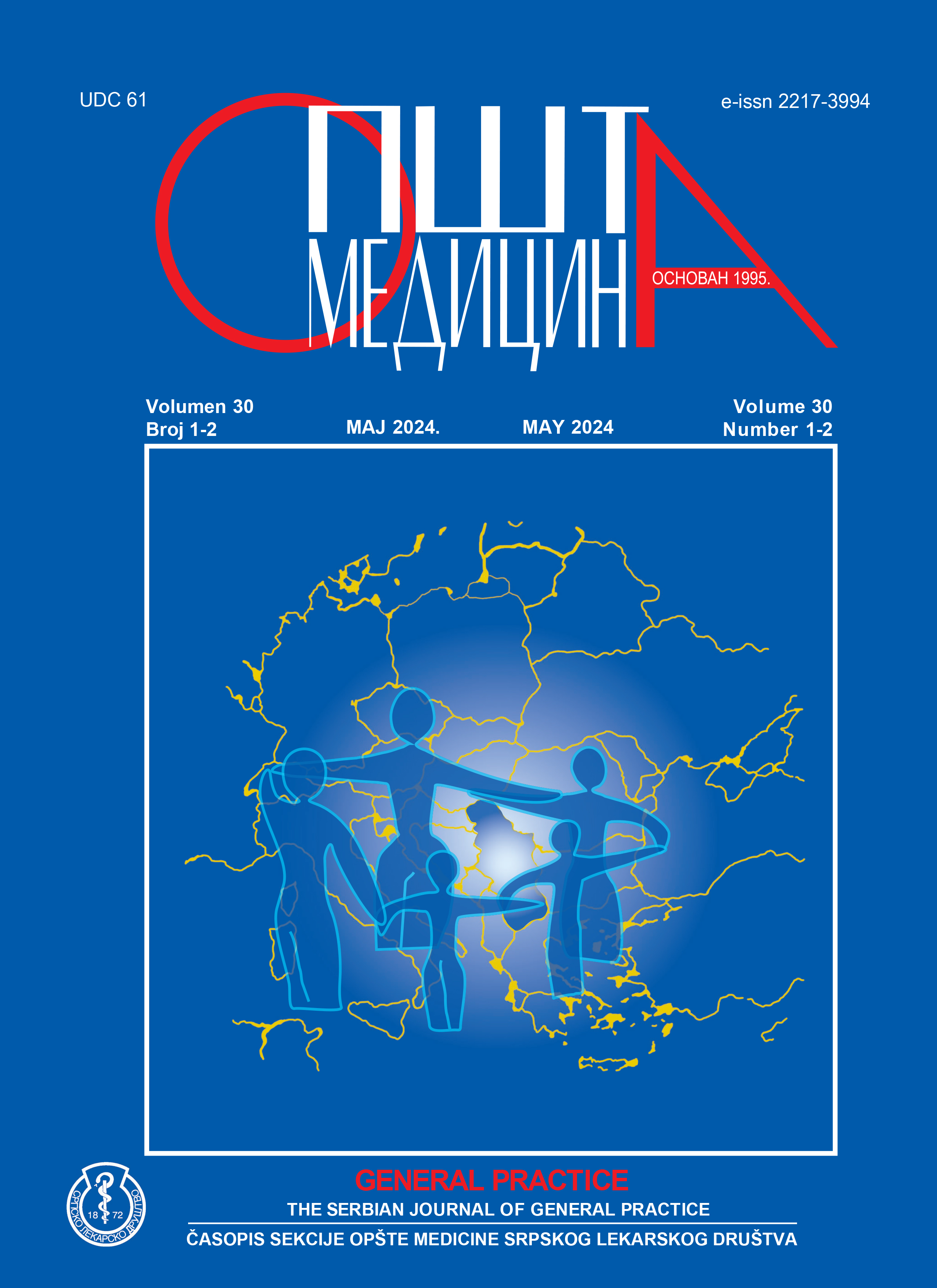General principals of emergency poisoning treatment in the general practice office – challanges and obstacles
Abstract
Introduction. Timely recognition of acute or chronic
poisoning, as well as the pharmacodynamic mechanisms and
pathophysiology of poisoning, is of the utmost importance in
the general practice office.
Objective. We aimed to find out the rate of awareness
and education of primary healthcare physicians on necessary
measures in the case of poisoning treatment.
Method. Physicans working in general practice in the
Republic of Serbia were sent an electronic questionnaire ’’Urgent
poisoning treatment in the general practice office’’. The
questionnaire had 13 questions referring to the physician’s
practical experience.
Results. The rise of medication, product, and biological
substance poisoning rate was registered at the primary
healthcare level in the last five years and it went from 0,14 to
0,21. Poisoning with non-medical substances is on the steep
decline, from 0,30 to 0,19 per 1000 inhabitants. We followed
the experience of general physicians (GPs) from outpatient
clinics, concerning the cases of acute and chronic poisoning,
by examining the questionnaire which showed 71,43% of
GPs met with this condition. Physicans were more likely to
be met with accidental poisoning (41,07%), while (21,43%)
were met with multiple intentional poisonings. A larger percentage
of these cases (44,65%) were treated on-site. About
the existence of the National Poisoning Control Center knew
53,57% of physicans and 58,93% were familiar with detoxication
measures. Additional expertise in the area of poisoning
is necessary in the opinion of 75% of physicians.
Discussion. Poison intake, in different ways, into a
body, may cause a patient’s death if not recognized on time,
at the initial encounter in the general physician’s office.
Conclusion. Awareness and education of the GPs in
the outpatient clinics, as well as, readiness to learn additional
skills proved to be an important factor in taking care of poisoned
patients who call on their GPs first. Continuous education
is a necessary measure for the improvement of healthcare
quality in the treatment of acute and chronic poisoning.
References
Zdravstveno-statistički godišnjak Republike Srbije. Beograd: Institut za javno zdravlje Srbije “Dr Milan Jovanović Batut“, 2021. Available from:: https://www.batut.org.rs/download/publikacije/pub2021a.pdf
Zdravstveno-statistički godišnjak Republike Srbije. Beograd: Institut za javno zdravlje Srbije “Dr Milan Jovanović Batut“, 2016. Available from: https://www.batut.org.rs/download/publikacije/pub201620180419.pdf
Ćirić T, Baralić K, Marić D, Javorac D, Đorđević AB, Miljaković EA, et al. Causes of acute poisoning with a fatal outcome in the Republic of Serbia in the period from 2010 to 2018. Arch Pharm 2022;72(Suppl 4):S593–S594.
Katić K, Stojadinović A, Mijatović V, Grujić M. Acute poisoning in children and adolescents hospitalized at the institute of child and youth health care of Vojvodina between 2015–2017. Med Pregl 2019;72(7-8):209–15.
Đorđević S, Perković Vukčević N, Antunović M, Kilibarda V, Vuković Ercegović G, Jović Stošić J, et al. Olanzapine poisoning in patients treated at the National Poison Control Centre in Belgrade, Serbia in 2017 and 2018: a brief review of serum concentrations and clinical symptoms. Arh Hig Rada Toksikol 2022;73(2):126–30.
Bulat P, Mandić-Rajčević S. Health risks due to the use of pesticides. In: Use of pesticides in plant production and environmental protection, 2019. p. 217–27.
Peričević-Medić S, Ljujić J, Mikov I, Španović M, Sakač S. Emergency carbon monoxide poisoning therapy for petroleum industry workers. Naučni časopis urgentne medicine HALO 194;2020;26(3):138–42.
Roksandić BI, Delić BS, Aracki NS, Petrović RD. Acute poisoning as urgent cases and care measures. ABC-časopis urgentne medicine 2020;20(1):11–9.
Ruhm, CJ. Corrected US opioid‐involved drug poisoning deaths and mortality rates, 1999–2015. Addiction 2018;113(7):1339–44.
Mégarbane B, Oberlin M, Alvarez C, Balen F, Beaune S, Bédry R, et al. Management of pharmaceutical and recreational drug poisoning. Ann Intensive Care 2020;10(1):157.
Medić SP, Ljujić J, Mikov I, Španović M, Sakač S. Urgentno zbrinjavanje trovanja ugljen monoksidom kod radnika naftne industrije. Naučni časopis urgentne medicine HALO 194 2020;26(3):138–42.
Banjac N, Maravić-Oplakan G, Vukadinović S. Acute poisoning by chemical agents in the Emergency Department in Banja Luka. ABC-časopis urgentne medicine 2008; 8(1-2):50–3.
Kuljančić D, Cvjetković-Bošnjak M. Pokušaj suicida u Covid 19 javnozdravstvenoj krizi. Timočki medicinski glasnik 2021;46(4):194–6.
Kostić E, Vujović M. Toksikološki izveštaji o trovanju pesticidima u jugoistočnom regionu Srbije tokom 2020. godine. XXVI savetovanje o biotehnologiji. Čačak, 2021. Zbornik radova. Univerzitet u Kragujevcu, Srbija, 2021;313–8.
Maksimović ŽM, Jović-Stošić J, Vučinić S, Perković-Vukčević N, Vuković-Ercegović G, Škrbić R, et al. Acute organophosphate and carbamate pesticide poisonings–a five-year survey from the National Poison Control Center Of Serbia. Drug Chem Toxicol 2023;46(1):113-121.
Andjelkovic M, Buha Đorđevic A, Antonijevic E, Antonijevic B, Stanic M, Kotur-Stevuljevic J, Bulat Z. Toxic effect of acute cadmium and lead exposure in rat blood, liver, and kidney. Int J Environ Res Public Health 2019;16(2):274.
Singh S, Li SSL. Phthalates: toxicogenomics and inferred human diseases. Genomics 2011;97(3):148–57.
Sree CG, Buddolla V, Lakshmi BA, Kim YJ. Phthalate toxicity mechanisms: An update. Comp Biochem Physiol C Toxicol Pharmacol 2023;263:109498.
Kovačević M, Baralić K, Djordjević AB, Ćurčić M, Miljaković EA, Bulat Z, et al. Acute poisonings by drugs used for the treatment of cardiovascular diseases in the Republic of Serbia. Arch Pharm 2022;72(Suppl. 4):S597–S598.
Copyright (c) 2024 Marija ž Lazarevic

This work is licensed under a Creative Commons Attribution-NonCommercial-ShareAlike 4.0 International License.
Autori zadržavaju autorska prava nad objavljenim člancima, a izdavaču daju neekskluzivno pravo da članak objavi, da u slučaju daljeg korišćenja članka bude naveden kao njegov prvi izdavač, kao i da distribuira članak u svim oblicima i medijima.

